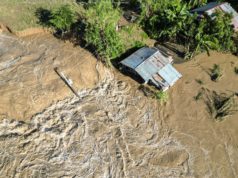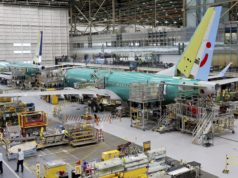It was exactly the type of accident that Uber and other self-driving car companies say their advanced sensors and computer programming should prevent.
Self-driving car experts are not surprised that someone was killed in a pedestrian accident involving the cutting-edge technology — nobody thought the cars would prevent all accidents.
But they are shocked at how dramatically the technology failed.
A 49-year-old woman was killed Sunday night in Tempe when she jaywalked with her bike across a dark section of Mill Avenue south of Curry. A self-driving Volvo operated by Uber struck and killed her.
It was exactly the type of accident Uber and other self-driving car companies say their advanced sensors and computer programming should prevent.
“This is not something I would expect artificial intelligence to struggle with,” said Jim McPherson, a California attorney and self-driving car consultant who has criticized the industry for moving too fast to put untested technology on public roads.
RELATED: Video shows moments before fatal Uber crash in Tempe Self-driving Uber vehicle strikes, kills 49-year-old woman in Tempe police chief: Fatal Uber crash likely ‘unavoidable’ for any kind of driver
Video released Wednesday of the accident shows the car not appearing to brake or steer away from pedestrian Elaine Herzberg as she walked across an open lane and in front of the car.
Herzberg appeared to be looking away from the oncoming vehicle, while an in-car camera shows Uber driver Rafaela Vasquez looking down at something below the dashboard, out of view of the camera, before the collision.
Drivers remain behind the wheel of Uber’s cars to take over when the cars autonomous systems fail.
The National Transportation Safety Board and National Highway Traffic Safety Administration are investigating, and industry experts are eager to see what they find regarding the robot car’s performance in what should have been a routine interaction with a pedestrian.
McPherson said allowing companies to test autonomous cars on public roadways should be re-examined in light of the accident, and testing perhaps should be limited to private proving grounds until the companies can statistically show the cars are safe.
“They should all definitely reassess,” McPherson said.
McPherson and other experts also question whether there was a problem with how the car was programmed.
It’s possible that the sensors in the car did detect the pedestrian and the car “decided” not to act based on its programming, said James Arrowood, who runs Arrowood Attorneys in Scottsdale and teaches the State Bar of Arizona course on driverless cars.
“The computer makes a decision. It says ‘Hey, there is this object moving 10 or 15 feet to left of me, do I move or not?'” he said. “It (could be) programmed, I have a right of way, on the assumption that whatever is moving will yield the right of way.”
Arrowood is an expert in motor-vehicle and product-liability issues. He based his comments on the public video only and does not represent anyone involved in the accident.
“Really what we are going to ask is, at what point should or could those sensors recognize the movement off to the left,” he said. “Presumably she was somewhere in the darkness.”
He said it is prudent for Uber to keep its cars off the road until the company understands why the car failed to, apparently, attempt to avoid the collision.
“What they are going to do is specifically look at the sensitivity of the sensors at night,” he said. “I know from representing vehicle manufacturers, they take this stuff seriously. They don’t want someone injured with it.”
Uber has operated its vehicles in the area for more than a year, and its dozens of Volvo SUVs have logged substantial miles on Mill Avenue where the accident occurred.
The company offered a reporter and photographer from The Arizona Republic rides in its Volvos last fall and operators told stories of when the sensor technology was more effective than human drivers.
The Uber employees who spend full-day shifts behind the wheel of the cars said that at night on Mill — when numerous people cross the street amid the restaurants and bars near Arizona State University — the cars are effective at anticipating jaywalkers.
READ MORE: How long before we all use driverless cars? Experts weigh in Here are 6 reasons Uber is betting big on Arizona
The operators said in the desert area to the north, near the accident scene, the sensors often prompt the cars to stop before operators see pedestrians who are walking in the dark on the side of the road toward the path of the vehicle.
However, during a daylight drive around ASU and up and down Scottsdale Road, the operators of the Uber vehicles had to take over the controls for multiple instances when the cars could not negotiate traffic on their own.
In one instance, the driver braked and turned the wheel because he was concerned the autonomous Volvo would not avoid a car in front of it as the Volvo changed lanes to turn onto Rio Salado Parkway.
Uber has touted the self-driving program as a way to improve safety.
“Self-driving cars have the potential to save millions of lives and improve quality of life for people around the world,” Uber’s press material for the program says. “1.3 million people die every year in car accidents — 94 percent of those accidents involve human error. In the future we believe this technology will mean less congestion, more affordable and accessible transportation, and far fewer lives lost in car accidents.”
Uber’s cars use a combination of cameras, radar and lidar to navigate and avoid obstacles. Lidar is like radar but using lasers instead of radio waves to construct a three-dimensional representation of the car’s surroundings. Uber officials have said it can detect objects 100 yards away.
“Lidar or radar, each has their shortcomings depending on light, reflectivity,” McPherson said. “Dark clothing and metal appear to one better than the other.”
Uber customers who have used the self-driving cars in the last year in Tempe have seen the three-dimensional images the sensors create. Uber installed special screens in the rear passenger area to explain the technology to riders.
The screens show the car and nearby curbs, landscaping, and as many as three cars ahead. The detail is pixelated, like an old video game, but the sensors show enough detail to pick out passengers riding in a bus next to the Uber vehicle.
Regardless of the failure of the car’s technology, Arrowood said the accident appears to be primarily caused by the pedestrian, and anyone suing for damages on her behalf faces a challenge.
Law firm Bellah Perez on Thursday announced it is representing Herzberg’s daughter, though officials did not say explicitly they will sue Uber or the driver.
“A lot of people think (Uber) will just write a check for a billion dollars or something,” Arrowood said. “That is not going to happen.”
He said he expects a settlement, not a jury trial. But any settlement Uber might pay will be calculated based on the victim’s lifetime earnings and life expectancy, both presumably low for a person living on the street.
“Whether people think that is fair or not, there is an analysis of lifetime earnings that is going to temper any judgement in a case like this,” he said.
Home
United States
USA — Events What went wrong with Uber's Volvo in fatal crash? Experts shocked by...






